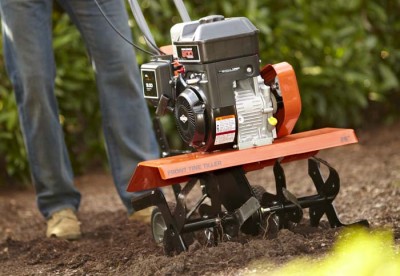
Image source: Lowes
For a long time my wife and I had sort of a running battle over the subject of my roto-tiller. I have watched vegetable gardeners and farmers alike going through the process of turning the soil each spring for as long as I can remember, and each year the crops roll in right on schedule. Seemed to be working just fine to me. So when we finally made the move to our homestead, my opinion when it came to the subject of vegetable gardening was, “If it ain’t broke, don’t fix it!” So I got myself a tiller.
First spring, I hit the dirt running with my trusty new tiller. I broke ground, built rows, carved out furrows, all that good stuff, and laid out our first garden. It went OK, for a first try, and we got our zucchini, a few melons, tomatoes, all the usual fare here in the Missouri Ozarks, along with collards and okra — a couple vegetables that I had brought a taste for with me from the South (why don’t you Midwestern folks understand how good this stuff is!?).
But come to find out, my “if it ain’t broke don’t fix it” attitude was a little off when it comes to garden tilling. There are some aspects of this time-proven method that are definitely broke!
Sadly for me it was my wife who caught onto this first, and I held on to my fondness for the tiller. There is a lot to commend the tiller, especially for a guy. It has a gas engine and makes a lot of noise. It has a lot of parts that vibrate loose on a regular basis and have to be tightened, fixed and replaced using tools. It’ll hurt you if you aren’t careful. It was hard to let go of. So, in the face of sound logic and scientific evidence I held firm to my desire to use my machine for a lot longer than was logical, as men often do!
So, what exactly are the problems with tilling? Three big ones stand out: its impact on microorganisms, soil compaction and erosion. These factors combine to degrade soil, necessitating constant soil amendment and even replacement, adding to costs and ultimately labor.
New Natural Fertilizer Doubles Garden Production!
Let’s start with microorganisms. Believe it or not, all the little creepy crawlies in the soil are a good thing. They aid in the decomposition of organic matter, which releases nutrients back into the soil. Some bacteria help to fix atmospheric (gaseous) nitrogen into forms that plants can utilize (plants can’t utilize nitrogen until it has been “fixed” or converted from the gaseous form). Others churn and aerate the soil. These are all very beneficial activities, and, in fact, they are the cornerstone of your soil’s ecosystem and without them your garden won’t grow unless it has chemical or fertilizer interventions. Most of these organisms live in the top 3 inches of soil, and tilling wreaks havoc with their environment, disrupting and displacing them. If these little guys are churned below their accustomed depth they can easily be killed and lost. Coincidentally, tilling has its greatest impact at these depths and is therefore very damaging to your soil’s “micro biota.” Such disruptions take a very long time to come back from, and the damage likely will not sort itself out by next season’s tilling, giving the whole cycle a compounding effect. At some point, the damage becomes almost irrevocable, and you are stuck using chemical concoctions to “replace” (sort of!) what nature was already supplying in the first place.
Story continues below video
Soil compaction goes hand-in-hand with the microbiological aspects of tilling damage. The action of the tiller, while loosening the very top layer of the soil, actually compacts the deeper soils at the interface, formed by the depth of your tiller splines, between tilled and untilled soils. If your soil has a significant clay component this is compounded, forming an almost watertight barrier. This not only traps too much moisture too near to the surface but also disrupts the natural migration of the nutrients, freed and fixed by microbial action into deeper soils where they can benefit root systems and be picked up by plants with deeper roots. It is at this interface that disrupted microbiological organisms displaced by the action of the tiller are most vulnerable to eradication.
The final area where tilling can cause a great deal of damage is in accelerating erosion. Tilling leaves the top soil bare and exposed. This is, after all, one of the goals of tilling — to let you start your garden in a “weed”-free environment. Unfortunately, all this exposed soil can be worked on by the wind and the rain, which can wash or blow away even more nutrients, soil and microorganisms. Part of the job of all those “weeds” you have just destroyed was to hold your ground in place. Remember the Dust Bowl years? An awful lot of tilled soil blew away forever, and a lot of farmers lost their livelihoods, and it didn’t do our nation’s food supply any good, either. Not saying that tillers are a Grapes of Wrath thing, but … all hyperbole aside, the erosion associated with tilling could very well have you replacing not only nutrients more regularly, but having to replace the soil itself.
I am not saying that tilling doesn’t have a place in your gardening plans. Breaking new ground for the first time may require it. An initial infusion of new soil, compost and other organic matter can sometimes best be integrated into poor soils with a tiller. But as a yearly ritual, it may not be the best idea. Remember: Your soil has a complex ecosystem of its own, and it has been working to keep things in balance long before you decided to put in your garden. Messing with a good system, put in place by the Creator of the universe, seldom produces better results and often does just the opposite!
What do you think about tilling? Post your comment in the section below:
Sign up for Off The Grid News’ weekly email and get $600 worth of survival blueprints … free!
 Off The Grid News Better Ideas For Off The Grid Living
Off The Grid News Better Ideas For Off The Grid Living




